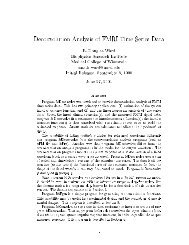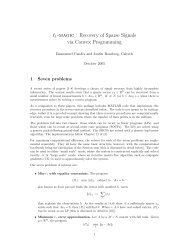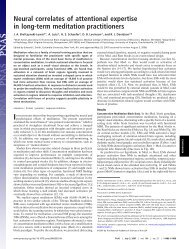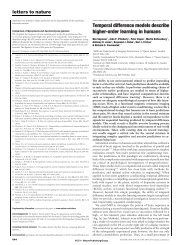The Duchenne Smile: Emotional Expression and Brain Physiology II
The Duchenne Smile: Emotional Expression and Brain Physiology II
The Duchenne Smile: Emotional Expression and Brain Physiology II
You also want an ePaper? Increase the reach of your titles
YUMPU automatically turns print PDFs into web optimized ePapers that Google loves.
DUCHENNE SMILE 345activation, happiness may not produce absolute left frontal activation.Rather, compared with disgust, one would expect moreleft frontal activation during happiness.In our experiment, subjects watched positive <strong>and</strong> negativeemotional film clips while they were unobtrusively videotaped.In addition, brain electrical activity was measured. We testedthe following specific hypotheses:Hypothesis 1: <strong>The</strong>re will be more <strong>Duchenne</strong> smiling whensubjects watch positive films than when they watch negativefilms, whereas other smiles will not distinguish whether subjectswatch positive or negative films.Hypothesis 2: <strong>The</strong> <strong>Duchenne</strong> smile but not other smiling willcorrelate with the subjective experience of positive emotions.Hypothesis 3: <strong>The</strong> <strong>Duchenne</strong> smile but not other smiles willpredict during which of two positive emotion films a subjectreported feeling most amused <strong>and</strong> most happy.Hypothesis 4a: <strong>The</strong> <strong>Duchenne</strong> smile will be accompanied bygreater left anterior (i.e., frontal <strong>and</strong> anterior temporal regions)activation compared with other smiles, whereas other smileswill be associated with more right-sided anterior activationcompared with the <strong>Duchenne</strong> smiles. Our prediction regardingother smiles is based on three facts. First, we previously foundthat in infants, other smiles were associated with more rightsidedfrontal activation compared with <strong>Duchenne</strong> smiles (Fox& Davidson, 1988). Second, the situation that elicited predominantlyother smiles in the infant study (i.e., stranger approach)also produced behavioral signs of withdrawal (gaze aversions),which Davidson (1984) has argued should be accompanied byrelative right-sided anterior activation. Finally, the facial behaviorthat accompanies the production of other smiles often includesaction units that are present during negative affect. Aswill be noted below, this also occurred in the present study.Hypothesis 4b: When compared with baseline, <strong>Duchenne</strong>smiling will be associated with relative left-sided anterior activation,whereas other smiling will be associated with relativeright-sided anterior activation.SubjectsMethodA total of 37 right-h<strong>and</strong>ed (assessed with the Edinburgh H<strong>and</strong>ednessInventory; Oldfield, 1971) women between the ages of 17 <strong>and</strong> 41 yearswere tested. <strong>The</strong> sample was restricted to right-h<strong>and</strong>ed subjects becauseasymmetry measures were being obtained. Of these 37 subjects, 34completed all of the ratings of subjective experience of emotion, <strong>and</strong> 3 Ihad some usable electroencephalogram (EEG) data during at least oneof the conditions.ProcedureSubjects were tested individually. Prior to the experiment they weretold that their subjective <strong>and</strong> physiological reactions to films designedto elicit both positive <strong>and</strong> negative emotions would be studied. <strong>The</strong> experimentbegan with baseline recordings of physiology, after which thefilm clips were presented. Following the presentation of the film clips,another set of baseline trials was presented.Emotion-Arousing Stimuli<strong>The</strong>re were five film trials, each comprising a different short film ofapproximately 90 s in duration. <strong>The</strong> first film clip was used to acclimatesubjects to the procedure. <strong>The</strong> next two were intended to evoke positiveemotions, <strong>and</strong> the last two were designed to evoke negative emotions.Prior research with these films (Ekman & Friesen, 1974; Ekman, Friesen,& Ancoli, 1980) had found that subjects reported strong feelingsof happiness <strong>and</strong> showed smiling expressions during the positive films.Feelings of fear, sadness, disgust, <strong>and</strong> pain <strong>and</strong> a variety of negative emotionalexpressions occurred in response to the negative films.All the films were silent <strong>and</strong> in color. One of the positive films showeda puppy playing with flowers. <strong>The</strong> second showed monkeys playing <strong>and</strong>gorillas taking a bath in the zoo. <strong>The</strong> order in which the puppy versusprimate film clip was presented was counterbalanced across subjects.<strong>The</strong> two negative films clips always followed the positive clips. <strong>The</strong>rationale for this was based on previous work by Ekman et al. (1980,1988) <strong>and</strong> by our own pilot work, which indicated that the negativeaffect elicited by the negative films tended to persist longer than the positiveaffect elicited by the positive films. If we had counterbalanced theorder of positive <strong>and</strong> negative films, the persisting negative affect wouldhave interfered with the intended effect of the positive films. <strong>The</strong> negativefilm clips were taken from training movies used in the teaching ofnurses. One clip depicted a leg amputation <strong>and</strong> the other was the sceneof a third-degree burn victim. Both were quite gruesome.Subjective Ratings of EmotionAfter each of the baseline <strong>and</strong> film trials, subjects rated the emotionsthey had felt during the preceding trial on a series of unipolar scales.Separate scales were included for interest, happiness, amusement, contentment,excitement, fear, sadness, anger, disgust, pain, <strong>and</strong> arousal.<strong>The</strong> instructions told the subject that zero represented no emotion <strong>and</strong>8 the most intense feeling of that emotion. <strong>The</strong>se rating scales were projectedone at a time on the rear projection screen. <strong>The</strong> subjects enteredtheir rating by pressing a number on their key pad.Video RecordingsDuring each of the film clips, subjects were videotaped unobtrusivelythrough a wire mesh screen that served as the border of the rear projectionscreen. <strong>The</strong> camera was absolutely invisible to the subject, <strong>and</strong> notone subject suspected that she was being videotaped. After the experimentwas completed, subjects were thoroughly debriefed, <strong>and</strong> writtenconsent was requested to use their videotapes for scientific purposes.<strong>The</strong> subject was told that if she did not wish for the tape to be used, itwould be erased. No subject declined our request to use her tape.EEG Recording Procedure<strong>The</strong> EEG was recorded from the left <strong>and</strong> right frontal, central, anteriortemporal, <strong>and</strong> parietal regions (F3, F4, C3, C4, T3, T4, P3, P4) allreferred to vertex (Cz) using a lycra stretchable cap (Electro-Cap). Formore information about these recordings, as well as more details aboutthe procedure, emotion-arousing stimuli, <strong>and</strong> video recordings, see theaccompanying article (Davidson, Ekman, Saron, Senulis, & Friesen,1990). That article also describes in the introduction eight methodologicaldesiderata for psychophysiological research on emotion that are relewantto this study as well.Data AnalysisScoring facial behavior. All of the observable facial activity shown byeach subject during the positive <strong>and</strong> negative films was measured withEkman <strong>and</strong> Friesen's (1976, 1978) Facial Action Coding System(FACS). FACS distinguishes 44 action units. <strong>The</strong>se are the minimalunits that are anatomically separate <strong>and</strong> visually distinctive. Any facial
346 P. EKMAN, R. DAVIDSON, AND W. FRIESENmovement can be described in terms of the particular action unit that,singly or in combination with other units, produced it. <strong>The</strong> scorer identifiesthe action units, such as the one that pulls the lip comers up orthat lowers the brow, rather than making inferences about underlyingemotional states such as happiness or ange~ or using descriptions thatmix inference <strong>and</strong> description such as smile, scowl, or frown. In additionto specifying which action units produced each observed expression,the beginning <strong>and</strong> end of each expression was determined.lntercoder reliability has been estabfished for this scoring procedurein a number of laboratories (cf. Ekman & Friesen, 1976; Ekman et al.,1980; Ekman, Friesen, & Simon& 1985; Ekman et al., 1988; Fox &Davidson, 1988; Krause et al., 1989; Ruth, 1987; Steiner, 1986). In ourstudy two coders who did not know the hypotheses each scored abouthalfofthe videotapes. Each ofthese coders had more than I year's experienceusing FACS, <strong>and</strong> their reliability had been established bothagainst a st<strong>and</strong>ard criterion (Ekman <strong>and</strong> Friesen's own scoring) <strong>and</strong>against each other.FACS scoring can provide either frequency or duration data on eachfacial action. <strong>The</strong> duration of facial actions is probably a more accurateindex of emotion because duration is sensitive to very long expressions,which may be given tittle weight if only frequency is considered. However,frequency is less costly to obtain because the precise onset <strong>and</strong>offset of each action is not required as it is to determine duration, <strong>and</strong>therefore most investigators have reported frequency data. In this experimentthe onset <strong>and</strong> offset of each facial action had to be determined tocoordinate the facial actions with the EEG record. All of the resultswere computed separately with frequency <strong>and</strong> duration scores. <strong>The</strong>rewere no differences in the significance levels obtained. We report onlythe duration data because we believe they represent the more accuratescores.Although the FACS scoring revealed that many different facial actionsoccurred apart from smiling behaviors, our hypotheses focused only ontwo groups of smiles. <strong>The</strong> <strong>Duchenne</strong> smile (D-smile) was composed ofall instances in which the smile was produced by the zygomatic majormuscle <strong>and</strong> the lifting of the cheeks <strong>and</strong> gathering of the skin around theeye were produced by the orbicularis oculi muscle. We deviated from<strong>Duchenne</strong> in excluding smiles in which the activity around the eyes wasdue to the inner str<strong>and</strong>s of the orbicularis oculi muscle (pars palpebralis),not the outer str<strong>and</strong>s (pars lateralis). We made this decision onthe basis of Ekman, Roper, <strong>and</strong> Hager's (1980) finding that fewer peoplecan voluntarily contract the outer as compared to the inner str<strong>and</strong>s ofthis muscle. This suggested that there would he greater certainty thatthe expression was involuntary if only instances in which the outer portionof the orbicularis oculi muscle were included in the category ofD-smiles.Other smiles (O-smiles) were composed of all other instances inwhich the smile was produced by the zygomatic major muscle but theorbicularis oculi, pars lateralis was absent. <strong>The</strong>se included instances inwhich the smile was produced by only the zygomatic major muscle, aswell as expressions in which this muscle was joined by a variety of otherfacial muscles, including facial actions associated with negative emotions.For each subject the total duration during which either type ofsmile occurred was computed for each of the two positive <strong>and</strong> two negativefilms.Artifact editing of EEG. All EEG records were visually scored forartifact. All eye movement <strong>and</strong> muscle artifacts were removed from thedata prior to analysis. If artifact was present on any channel, data fromall channels were removed so that the EEG data were always taken fromcoincident points in time.EEG analysis. <strong>The</strong> main EEG data in this experiment were derivedfrom the positive film clips during those periods when the <strong>Duchenne</strong>smile <strong>and</strong> other smiles were present <strong>and</strong> no artifact was present. <strong>The</strong>onset <strong>and</strong> offset times of these facial expressions were entered into thecomputer along with the times during which artifact was not present.<strong>The</strong> computer then extracted those portions of the EEG record thatwere 1.02 s or longer in duration for analysis that corresponded to theoverlap of these two criteria. We chose to extract the EEG during eachof these two smile types in response to the positive film clips only, becausethe D-smiles occurred with far more frequency during the positivecompared with the negative clips. If we were to have used all instancesof D-smiles <strong>and</strong> O-smiles, the comparison would have confoundeddifferent smile types with different film clips in response towhich they were elicited.For analyses of the baseline periods, we used only the eyes-open trialsbecause they were considered to be the most appropriate comparisonsfor the film conditions during which subjects' eyes were also open. Allartifact-free periods of EEG from the pre- <strong>and</strong> postfilm baseline trialsthat were 2.05 s or more in duration were used in the analysis. Chunksof EEG (l.02-s periods for the facial expressions <strong>and</strong> 2.05-s periods forthe baseline) were extracted using a Hamming window <strong>and</strong> were overlappedby 75%. A Fast Fourier Transform was applied to each chunk ofEEG. Power values from successive chunks within a condition (i.e.,smile type or baseline) were averaged. <strong>The</strong> dependent measures thatwere extracted from this analysis were power density (in ~V2/Hz) in thealpha (8-13 Hz) <strong>and</strong> beta (l 3-20 Hz) b<strong>and</strong>s. Power in the alpha b<strong>and</strong> isinversely related to activation, so that lower values denote more activation(Lindsiey & Wicke, 1974). Beta power was also examined. However,on the basis of our previous data <strong>and</strong> comparisons among b<strong>and</strong>s in EEGasymmetry in response to carefully matched tasks, we hypothesizedthat the major effects would occur in the alpha b<strong>and</strong> (see the accompanyingreport for additional details on the EEG analysis methods; Davidson,Chapman, Chapman, & Henriques, in press).ResultsDid the Type of <strong>Smile</strong> Vary With theExperimental Condition?Hypothesis 1 predicted that there would be more D-smileswhen subjects watch positive films than when they watch negativefilms, whereas O-smiles would not distinguish whether subjectswere watching positive or negative films. To test this hypothesis,four summary scores were computed for each subject:the duration of D-smiles <strong>and</strong> O-smiles summed over the twopositive films <strong>and</strong> summed over the two negative films. <strong>The</strong>sefour scores were entered into a 2 X 2 Film Type (positive-negative)X <strong>Smile</strong> Type (D-smile-O-smile) repeated measures analysisof variance (ANOVA).A significant main effect for film type, F(1, 36) = 40.22, p
DUCHENNE SMILE 347Durationof <strong>Smile</strong>s(sec)25201510\PositiveFilmNegativeFilmOther <strong>Smile</strong>s<strong>Duchenne</strong> <strong>Smile</strong>sFigure 3. Mean duration (in seconds) of each type of Duehenne's smile<strong>and</strong> other smiles in response to the positive <strong>and</strong> negative film clips.was 10:1, <strong>and</strong> the ratio of O-smiles during positive as comparedto negative films was 2:45 to I.Did the Type of <strong>Smile</strong> Relate to the SubjectiveExperience of Emotion?Hypothesis 2 predicted that D-smiles but not O-smilingwould be correlated with the subjective experience of positiveemotions. Whereas researchers studying the self-report ofmood (Clark & Watson, 1988; Diener & Emmons, 1984; Stone,1981) have argued against distinguishing among types of positivemoods, we (Ekman, 1977; Ekman & Friesen, 1975) haveargued for making such distinctions among emotions. We agreewith Tomkins (1962) that interest <strong>and</strong> excitement refer to adifferent state than happiness or enjoyment. As Woodworth(1938, p. 411) said, "<strong>The</strong> fact is that there are many kinds ofpleasant feeling, <strong>and</strong> of unpleasant. Some of the words do notindicate whether the feeling is pleasant or unpleasant; excitementmay be happy excitement or unhappy excitement, <strong>and</strong>this is true of expectancy <strong>and</strong> surprise."Although the D-smile may occur with interest <strong>and</strong> excitement,it will only do so in circumstances in which those emotionsblend with or occur in sequence with amusement or happiness.In our experiment interest <strong>and</strong> excitement, if felt, wouldoccur interspersed with amusement <strong>and</strong> happiness. Thus, if D-smiles are correlated with reports of interest <strong>and</strong> excitement, itwould be due to the association of those feelings with amusement<strong>and</strong> happiness.We consider happiness <strong>and</strong> enjoyment as general terms thatcover a variety of different positive emotional experiences suchas sensory pleasure, relief, satisfaction with accomplishment,amusement, <strong>and</strong> contentment. Although we expect that each ofthese positive emotions is experienced differently, with differentsensations <strong>and</strong> physiology, we (Ekman & Friesen, 1982) havehypothesized that all of these positive states share the same expressivesignal--the <strong>Duchenne</strong> smile.Because the positive films shown to the subjects were designedto be amusing, we predicted that D-smiles but not O-smiles would be correlated with reports of either the more specificterm amusement or the more general report of happiness.We did not expect a substantial correlation between D-smiles<strong>and</strong> contentment because these films were not likely to elicitmuch contentment.Table l reports the correlations between the duration of <strong>Duchenne</strong><strong>and</strong> other smiling with each oftbe emotion self-reports.Hypothesis 2 was supported. Only D-smiles, as predicted, werecorrelated with reports of amusement <strong>and</strong> happiness. D-smileswere also positively correlated with excitement <strong>and</strong> interest, althoughthese relationships were not as strong as the correlationsbetween D-smiles <strong>and</strong> amusement or happiness. <strong>The</strong> correlationbetween D-smiles <strong>and</strong> amusement was significantly greaterthan the correlation between D-smiles <strong>and</strong> either excitement(t = 2.49, p < .0 l) or interest (t = 2.22, p < .05, one-tailed tests).<strong>The</strong> correlation between D-smiles <strong>and</strong> happy was significantlygreater than the correlation between D-smiles <strong>and</strong> excitement(t = 1.69,p < .05).Partial correlations showed that the relationships between D-smiles <strong>and</strong> either interest or excitement were, as we predicted,enormously reduced when the variance associated with amusementwas removed. Table 2 shows that when the self-reports ofhappiness or amusement were partialled out, the correlationsbetween D-smiles <strong>and</strong> either interest or excitement disappeared.<strong>The</strong> converse was not so; when the influence of eitherinterest or excitement was partialled out, the correlations betweenD-smiles <strong>and</strong> either amusement or happiness survived.Because amusement <strong>and</strong> happiness ratings were highly correlated(.79 l), we computed partial correlations with D-smiles<strong>and</strong> these two ratings. Table 2 shows that when the influence ofhappiness ratings was controlled, the partial correlation betweenD-smiles <strong>and</strong> amusement was still substantial. However,when the influence of amusement ratings was controlled, thepartial correlation between D-smiles <strong>and</strong> happiness was enormouslyreduced.Table l shows two other findings that were not predicted byHypothesis 2. D-smiles were negatively correlated with reportsof feeling anger <strong>and</strong> sadness, <strong>and</strong> O-smiles were positively correlatedwith the report of disgust.Hypothesis 3 predicted that D-smiles but not O-smiles wouldpredict during which of the two positive films a subject had reportedfeeling most amused <strong>and</strong> most happy. This is a difficultdiscrimination because both the puppy <strong>and</strong> the primate filmshad evoked ratings that were at or very close to the median on
348 a. EKMAN, R. DAVIDSON, AND W. FRIESENTable 1Correlations Between Type of <strong>Smile</strong> <strong>and</strong> Self-Reported Emotions (N = 34)Type Amusement Happy Excitement Interest Contentment Anger Disgust Fear Pain Sad<strong>Duchenne</strong> smile .703* .594* .387*** .401"** .199 -.381"** -.322 -.299 -.218 -.439**Other smiles .135 .180 .080 .189 .104 .283 .340** .079 .259 .263* p < .001, one-tailed test. ** p < .01, two-tailed test. *** p < .05, two-tailed test.amusement <strong>and</strong> on happiness. In this idiographic analysis, asubject was considered correctly classified if the duration ofsmiling shown during the two films coincided with the positiveemotion ratings on the two films. Thus, a "hit" could occur inone of three ways: <strong>The</strong> puppy film was rated more positivelythan the primate film <strong>and</strong> there was more smiling during thepuppy film than during the primate film; the two films wererated the same <strong>and</strong> there was no difference in the amount ofsmiling; or the ratings on the puppy film were less positive thanfor the primate film <strong>and</strong> there was less smiling during the puppyfilm. <strong>The</strong> six possibilities in which the ratings <strong>and</strong> amount ofsmiling disagreed were considered to he "misses:'One-way chi-square analyses were computed using theamusement <strong>and</strong> happiness ratings on the two films. <strong>The</strong> expectedhit rate was set at .33 because there was a total of ninecombinations of ratings <strong>and</strong> smiles, three of which were hits<strong>and</strong> six of which were misses. Table 3 shows that predictions ofwhich film was most amusing or evoked most happiness wasaccurate when made on the basis of the amount of D-smiles butnot on the basis of O-smiles. Two by two chi-square analyseswere also computed on the hit-miss rate by type of smiling. <strong>The</strong>difference in the hit rate between D-smiles <strong>and</strong> O-smiles wassignificant for the happiness ratings (x 2 = 3.31, p < .05, onetailed)<strong>and</strong> marginal for the amusement ratings (x 2 = 2.13, p =.08, one-tailed test).Were the Types of <strong>Smile</strong> Associated With Differencesin <strong>Brain</strong> Asymmetry?<strong>The</strong> EEG during D-smiles <strong>and</strong> O-smiles was extracted fromthe two positive films. We included in this analysis only thosesubjects who had both D-smile <strong>and</strong> O-smile periods so that thedesign could he completely within subjects. A total of 13 subjectshad at least one instance of D-smiling <strong>and</strong> O-smilingwithin the positive film clips that coincided with artifact-freeEEG. Of these 13 subjects, 7 had facial signs of negative affectpresent during other smiles. <strong>The</strong> mean durations of D-smile<strong>and</strong> O-smile periods that were extracted for analysis were 20.9<strong>and</strong> 21.6 s, respectively.Our strategy for analysis was to first compare the D-smiles,O-smiles, <strong>and</strong> baseline conditions by computing separate 3 x 2ANOVAS with condition (D-smile-O-smile-baseline) <strong>and</strong> hemisphere(left-fight) as repeated factors on EEG power from eachof the four regions. <strong>The</strong>se overall analyses used the Huynh-Feldt correction to correct for departures from homogeneity ofvariance given a repeated factor with more than two levels. TwowayANOVAS on each pair of conditions were then computedto decompose the interaction. <strong>The</strong> major findings were derivedfrom analyses of alpha power, as we had predicted. After presentingthe data on alpha power, we also present the results ofanalyses on heta power.Alpha PowerAnterior regions. <strong>The</strong> ANOVA on the frontal data revealed asignificant Condition (D-smile-O-smile--baseline) x Hemisphereinteraction, F(2, 24) = 3.3 l,p = .054, with Huynh-Feldtcorrection, <strong>and</strong> no significant main effects. This interaction wasdecomposed by performing separate Condition x HemisphereANOVAs for each pairwise condition combination. <strong>The</strong> ConditionX Hemisphere interaction for the comparison between D-smiles <strong>and</strong> O-smiles was not significant, F(I, 12) = 2.06, failingto support Hypothesis 4a for the frontal data. In comparing D-smiles with baseline, the Condition × Hemisphere interactionwas also not significant, F(I, 12) = 1.55. However, the Condition× Hemisphere interaction was significant for the O-smileversus baseline comparison, F(I, 12) -- 5.53, p = .04, supportingone component of Hypothesis 4b (Figure 4). This interactionis a function of a significant decrease in fight frontal alphapower (i.e., more activation) during O-smiles compared withbaseline (p < .01). Left-hemisphere alpha power did not differsignificantly between baseline <strong>and</strong> the O-smiles. During O-smiles, absolute fight frontal activation was found, with signifi.Table 2Partial Correlations Between D-<strong>Smile</strong>s <strong>and</strong> Self-Reported EmotionsD-smile <strong>and</strong> D-smile <strong>and</strong> D-smile <strong>and</strong> D-smile <strong>and</strong>Partialing on excitement interest amusement happinessAmusement -.013 -.077 .089Happiness -.026 .189 .474Excitement .637 .489Interest .633 .506
Table 3Discrimination Between Which of the Two Positive Films WasRated as Most Happy or Most Amusing on the Basisof D-<strong>Smile</strong>s <strong>and</strong> O-<strong>Smile</strong>s% of hits Chi-square pHappiness ratings<strong>Duchenne</strong> smiles 73 25.25 .0001Other smiles 41 ! .027 nsAmusement ratings<strong>Duchenne</strong> smiles 65 15.45 .0001Other smiles 44 1.899 nsDUCHENNE SMILE 349cantly less right-hemisphere compared with left-hemisphere alphapower (p < .0 l).<strong>The</strong> overall ANOVA on the anterior temporal EEG revealed aCondition (D-smile-O-smile-baseline) × Hemisphere interactionthat fell just short of significance, F(2, 24) = 3.23, p < .06,with Huynh-Feldt correction. As we observed for the otherbrain regions, no significant main effects were obtained. <strong>The</strong>Condition x Hemisphere interaction for the direct comparisonof the D-smile <strong>and</strong> O-smile periods also fell short of significance,F(l, 12) = 3.79, p < .08. Because this interaction waspredicted by Hypothesis 4a, we computed the simple effects. AsFigure 5 indicates, D-smiles were associated with significantlymore left anterior activation (i.e., less alpha power) comparedwith O-smiles (p < .05). No difference between smile types wasfound in the right anterior temporal region. Alpha power in theleft <strong>and</strong> right anterior regions did not differ during D-smiles.However, during O-smiles, we found significantly more (p
350 P. EKMAN, R. DAVIDSON, AND W. FRIESENcomposed this interaction, we found that for this region,the Condition (D-smile-O-smile) × Hemisphere interactionfor the direct comparison between smile types was significant,F(I, 12) = 5.72, p = .03, <strong>and</strong> no main effects were obtained. AsFigure 6 indicates, the D-smiles were associated with more leftparietal activation compared with the O-smiles (p < .01). Nosignificant difference between smile types was obtained in theright hemisphere. During D-smiles, the left <strong>and</strong> right parietalregions did not differ from one another. Howev~ during O-smiles, the right parietal region was significantly (p < .01) moreactive than the left (i.e., showing less alpha power).When comparisons between each of the smile types <strong>and</strong> baselinewere made, a Condition × Hemisphere interaction wasfound only for the O-smile versus baseline comparison, F(I,12) = 7.23, p = .02. Again, no significant main effects were obtainedin this analysis. Compared to baseline, O-smiles wereassociated with a significant decrease in right parietal alpha activity(p < .001).We did not have any specific a priori predictions regardingdifferences between smile types in central asymmetry. However,we examined asymmetry in this region because of its relationwith motor production. If the differences in asymmetry betweensmile types were a function of differences in motor asymmetrybetween them, we would expect to find central asymmetryto differentiate between D-smiles <strong>and</strong> O-smiles. <strong>The</strong> overallANOVA on the central data revealed no significant differencesin asymmetry among the three conditions.Beta PowerSome researchers have suggested that alpha <strong>and</strong> beta activitymay reflect different components or types of activation (e.g.,Ray & Cole, 1985). In previous work, we have found that whencarefully matched tasks are compared on measures of EEGasymmetry, power is attenuated in the hemisphere putativelymost activated by the task in all frequency b<strong>and</strong>s. However,power reduction in the specialized hemisphere is most consistentlyfound in the alpha b<strong>and</strong> (Davidson et al., in press). Toaddress this issue in the present study, we recomputed all of themajor analyses with beta (13-20 Hz) power as the dependentmeasure. <strong>The</strong> Condition (baseline-D-smile-O-smile) × Hemisphereinteraction was not significant for frontal, F(2, 24) -- .44;anterior temporal, F(2, 24) = 1.61; or central,/7(2, 24) = .79,region activity. Nor were any main effects significant in thesethree regions. <strong>The</strong> Condition × Hemisphere interaction was significantfor the parietal region, F(2, 24) -- 4.01, p < .04, withHuynh-Feldt correction. Follow-up analyses indicated that thiseffect was a function of a significant Condition X Hemisphereinteraction for the baseline versus other smile comparison, F(I,12) = 6.82,p < .03. Paired comparisons revealed that this interactionwas a function of other smiles eliciting less beta activitycompared with baseline in the right hemisphere (p < .05). Nodifference between conditions was found in the left hemisphere.DiscussionWe have found consistent evidence supporting Ekman <strong>and</strong>Friesen's (1982) proposal for distinguishing among types ofsmiling rather than treating smiles as a single class of behavior.Specifically, the <strong>Duchenne</strong> smile was found, as predicted, to berelated to enjoyment--in terms of when it occurs <strong>and</strong> how itrelates both to subjective experience <strong>and</strong> distinctive physiologicalchanges--<strong>and</strong> other smiling was not. Clearly the Ducbennesmile, in which the orbicularis oculi, pars lateralis muscle thatorbits the eye is contracted in addition to the zygomatic majormuscle's pull on the lip corners, is a better sign of enjoymentthan other kinds of smiles. A number of other investigators followingEkman <strong>and</strong> Friesen's suggestion have also found evidencethat the <strong>Duchenne</strong> smile is associated with enjoymentin psychiatric patients (Kxause et al., 1989; Matsumoto, 1986;Steiner, 1986), in infants (Fox & Davidson, 1988), in children(yon Salisch, 1989), <strong>and</strong> in normal adults (Ruch, 1987).Ekman <strong>and</strong> Friesen (1982) predicted that <strong>Duchenne</strong> smilesare the signal for any of the positive emotions, such as amusement,relief, contentment, satisfaction with achievement, orsensory pleasure, as well as the more general positive emotionterms such as enjoyment or happiness. <strong>The</strong> stimulus films weused to arouse positive emotions showed amusing events, notother types of positive emotions, <strong>and</strong> as expected, <strong>Duchenne</strong>smiles correlated with the report of amusement rather thancontentment. Although <strong>Duchenne</strong> smiles also were correlatedwith reports of the more general term happiness, partial correlationsshowed that this was due to the correlation between happiness<strong>and</strong> amusement ratings. If other situations were examinedin which the subjects experienced relief, contentment, orsensory pleasure rather than amusement, we would expect D-smiles to correlate with the subjective experience of those emotions,not amusement, but this remains to be demonstrated.Although Watson <strong>and</strong> Tellegen (1985) included interest <strong>and</strong>excitement in their positive mood scale, we <strong>and</strong> other emotiontheorists (Tomkins, 1962; Woodworth, 1938)consider interest<strong>and</strong> excitement as separate states that may or may not be accompaniedby positive emotions. Our finding that <strong>Duchenne</strong>smiles were unrelated to reports of interest or excitement whenthe influence of amusement or happiness ratings was partialledout provides some support for our position. This finding doesnot necessarily contradict Watson <strong>and</strong> Tellegen, however, becausethey examined self-reports of moods, <strong>and</strong> we examinedthe relationship between momentary expression <strong>and</strong> momentaryreports of emotion.<strong>The</strong> question might be raised as to why other smiles occurredat all during the positive film if these are not enjoyment smiles.Our measurements did not distinguish among but instead combinedthe various kinds of other smiles (Ekman, 1985, has described17 types of other smiles that are said to differ from eachother in appearance). We expected that a particular type ofother smile would occur when watching the puppy <strong>and</strong> primatesfilms. <strong>The</strong>se are what we have described as "anticipatorysmiles;' in which the person is anticipating but not yet experiencingenjoyment. It is also possible that other smiles may be asign of less intense enjoyment. We also expected that some ofthe other smiles would include facial actions associated withnegative emotions. In fact, a majority of subjects included inthe EEG analyses had facial action units associated with negativeaffect in their other smiles. Such expressions may have beenshown by those subjects who reported, in postexperiment inter-
DUCHENNE SMILE 351views, negative emotional reactions to what they interpreted asteasing of the puppy or the confinement of apes in a zoo. <strong>The</strong>EEG data during other smiles certainly support the possibilitythat at least when they occur when watching the positive films,the other smiles are actually a sign of negative affect. Other researchin which the subjective report of emotion is obtainedimmediately after the appearance of the smile, <strong>and</strong> in whichmore samples of different kinds of other smiles are examinedin relation to the measures of cerebral asymmetry, is needed tofurther explore these possibilities.<strong>The</strong> amount of <strong>Duchenne</strong> smiling also was related to differencesamong positive affect experiences, not just the grosset distinctionbetween positive <strong>and</strong> negative affect. Making such asubtle distinction as to which of two positive experiences is themost positive was not possible based on other smiling.It is worth noting that the subjects were alone when they werewatching the films <strong>and</strong> did not know they were being videotapedor observed. As predicted, facial expressions did occur inthis solitary situation. <strong>The</strong>se expressions were not r<strong>and</strong>om, butinstead were related to the type of film viewed, the subjectivereport, <strong>and</strong> physiology. In this respect these data are consistentwith earlier reports that facial expressions of emotion do occurwhen people are alone (Ekman, 1972; Ekman et al., 1980) <strong>and</strong>contradict the theoretical proposals of those who view expressionssolely as social signals. This is not to suggest that our findingsmean that emotional experience or expression has nothingto do with social interaction. It is only that emotions can occurwhen one is alone as well as when one is with others. Obviously,it is the actions ofotbers that most often bring forth an emotion.More specifically, the presence of others who are also experiencingenjoyment typically will increase enjoyment expressions,even when the source of the enjoyment is not a conversationbut an activity such as watching a film.<strong>The</strong> cerebral asymmetry findings indicate that, as predicted,the two types of smiling differ in the pattern of regional brainactivity with which each is associated. <strong>Duchenne</strong> smiles are associatedwith more left-sided anterior temporal <strong>and</strong> parietal activationcompared with other smiles. Although the left-sided anteriortemporal activation was predicted to accompany positiveaffect, it is not clear what activation of the left parietal regionmight reflect in this study. Other EEG asymmetry studies havefound that verbal cognitive activity reliably increases left parietalactivation (e.g., Davidson et al., in press; Ehrlichman &Wiener, 1979). It is therefore possible that in the present context,the <strong>Duchenne</strong> smiles were accompanied by more verbalthinking compared with other smiles. In future studies it wouldbe useful to assess cognitive activity in addition to experiencedemotion, in order to evaluate this suggestion. <strong>The</strong> lack of anydifference in central EEG activity between the <strong>Duchenne</strong> smiles<strong>and</strong> other smiles suggests that the differences in asymmetry betweenthese smile types that were seen in other regions are nota function of differences in motor asymmetry, because centralEEG asymmetries are very sensitive to motor differences betweenthe two sides of the body (e.g., Coles, Gratton, Bashore,Eriksen, & Donchin, 1985; Kutas & Donchin, 1974).Other smiles show a pattern of activation asymmetry similarto what has been reported for withdrawal-related negative affect(see Davidson et al., 1990). In fact, when we examined othersmiles, we found that the majority did contain facial actionsdenoting negative emotion.Contrary to prediction, <strong>Duchenne</strong> smiles did not differ signifieantlyfrom baseline. This is the same pattern as was foundfor happy facial expressions in the accompanying article (Davidsonet al., 1990). Davidson (1984) has reasoned that positiveemotion is associated with left-sided anterior activation relativeto a baseline only when the positive emotion is accompanied byapproach behavior. As we noted in the accompanying article(Davidson et al., 1990), not all forms of positive affect includean approach component. <strong>The</strong> <strong>Duchenne</strong> smile marks a numberof rather different positive affective states, not all of which involveapproach. For example, contentment may not involve eitherapproach or withdrawal. Amusement may involve approach(when it develops in response to a comedian unfoldinga funny joke), or it may not, as we believe happened when subjectswere amused watching our films of a dog, monkeys, <strong>and</strong>gorillas playing. <strong>The</strong> reason for our failure to find a differencein anterior asymmetry between <strong>Duchenne</strong> smiles <strong>and</strong> baselinemay be that in this context, the <strong>Duchenne</strong> smile marked a formof positive affect with little or no approach component. In studieswhere unambiguous indices of approach behavior accompaniedpositive affect (i.e., an infant reaching toward its mother<strong>and</strong> smiling), significant left anterior activation was observedrelative to a preceding comparison condition (Fox & Davidson,1987, 1988). In the accompanying article, we offer several suggestionsfor how to measure "approach" happiness so that thisform of positive affect can be compared with other nonapproachforms of positive affect, such as the type of amusementelicited in this study. We also make clear that our idea that theamusement aroused in our experiment did not involve approachis admittedly ad hoc. We offer other alternative interpretationsof our data, <strong>and</strong> explain why we believe they are lesstenable.<strong>The</strong> analysis of beta power activity revealed little. As expected,the majority of the significant effects were in the alphab<strong>and</strong>. <strong>The</strong> only finding to reach significance for beta power wasthe difference in asymmetry between baseline <strong>and</strong> other smilesin the parietal region. <strong>The</strong> direction of this difference was identicalto that found in alpha power--more power suppression inthe right hemisphere during other smiles compared with baseline.<strong>The</strong> fact that alpha <strong>and</strong> beta power change in the samedirection is consistent with other findings from our laboratoryon EEG asymmetries in these b<strong>and</strong>s in response to wellmatchedcognitive tasks (Davidson et al., in press).Quite apart from what we have learned about the <strong>Duchenne</strong>smile as an index of enjoyment, our study also showed the feasibility<strong>and</strong> value of obtaining multiple measures in the studyof emotion. Measures of facial expression were related to selfreport<strong>and</strong> to different patterns of concomitant brain activity.In another report (Davidson et al., 1990) we extend our focusbeyond smiles, considering negative facial expressions as wellas positive ones, <strong>and</strong> again show the value of combining expressive<strong>and</strong> physiological measures in the study of emotion.ReferencesAndrew, R. J. (1963). Evolution of facial expression. Science, 141,1034-1041.
352 P. EKMAN, R. DAV1DSON, AND W. FRIESENBirdwhistell, R. L. (1963). <strong>The</strong> kinesic level in the investigation of emotions.In P. H. Knapp (Ed.), <strong>Expression</strong> of the emotions in man (pp.123-139). New York: International Universities Press.Birdwhistell, R. L. (1970). Kinesics <strong>and</strong> context. Philadelphia: Universityof Pennsylvania Press.Blurton Jones, N. G. (1972). Non-verbal communication in children.In R. A. Hinde (Ed.), Nonverbalcommunication (pp. 271-296). Cambridge:Cambridge University Press.Brannigan, C. R., & Humphries, D. A. (1972). Human nonverbal bebavior,a means of communication. In N. G. Blurton Jones (Ed.),Ethological studies of child behavior (pp. 37--64). Cambridge: CambridgeUniversity Press.Bruner, J. S., & Tagiuri, R. (1954). <strong>The</strong> perception of people. In G.Lindzey (Ed.), H<strong>and</strong>book of social psychology (Vol. 2, pp. 634--654).Reading, MA: Addison-Wesley.Clark, L. A., & Watson, D. (1988). Mood <strong>and</strong> the mundane: Relationsbetween daily life events <strong>and</strong> self-reported mood. Journal of Personality<strong>and</strong> Social Psycholog~, 54, 296-308.Coles, M. G. H., Gratton, G., Bashore, T. R., Eriksen, C. W., & Donchin,E, (1985). A psychophysiological investigation of the continuousflow model of human information processing. Journal of ExperimentalPsychology: Human Perception <strong>and</strong> Production, 11, 529-553.Darwin, C. (1955). <strong>The</strong> expression of the emotions in man <strong>and</strong> animals.New York: Philosophical Library. (Original work published 1872)Davidson, R. J. (1984). Affect, cognition <strong>and</strong> hemispheric specialization.In C. E. Izard, J. KaZan~ & R. Zajonc (Eds.), Emotion, cognition<strong>and</strong> behavior (pp. 320-365). New York: Cambridge University Press.Davidson, R. J. (1987). Cerebral asymmetry <strong>and</strong> the nature of emotion:Implications for the study of individual differences <strong>and</strong> psychopathology.In R. Takahashi, P. Flor-Henry, J. Gruzelier, & S. Niwa (Eds.),Cerebral dynamics, laterality <strong>and</strong> psychopathology (pp. 71-83). NewYork: Elsevier.Davidson, R. J., Chapman, J. P., Chapman, L. P., & Henriques, J. B. (inpress). Asymmetrical brain electrical activity discriminates betweenpsychometrically matched verbal <strong>and</strong> spatial cognitive tasks. Psychophysiology.Davidson, R. J., Ekman, P., Saron, C., Senulis, J., & Friesen, W. V.(1990). Approach-withdrawal <strong>and</strong> cerebral asymmetry: <strong>Emotional</strong>expression <strong>and</strong> brain physiology I. Journal of Personality <strong>and</strong> SocialPsychology, 58, 330-341.Diener, E., & Emmons, R. A. (1984). <strong>The</strong> independence of positive <strong>and</strong>negative affect. Journal of Personality <strong>and</strong> Social Psychology, 47,1105-1117.<strong>Duchenne</strong>, B. (in press). <strong>The</strong> mechanism of human facial expression oran electro-physiological analysis of the expression of the emotions (A.Cuthbertson, Trans.). New York: Cambridge University Press. (Originalwork published 1862)Ehrlichman, H., & Wiener, M. S. (1979). Consistency of task-relatedEEG asymmetries. Psychophysiology, 16, 247-252.Ekman, P. (1972). Universals <strong>and</strong> cultural differences in facial expressionsof emotion. In J. Cole (Ed.), Nebraska Symposium on Motivation,1971 (pp. 207-283). Lincoln: University of Nebraska Press.Ekman, P. (1977). Biological <strong>and</strong> cultural contributions to body <strong>and</strong>facial movement. In J. Blacking (Ed.), <strong>The</strong> anthropology of the body(pp. 34-84). London: Academic Press.Ekman, P. (1985). Telling lies. New York: W. W. Norton.Ekman, P. (1989). <strong>The</strong> argument <strong>and</strong> evidence about universals in facialexpressions of emotion. In H. Wagner & A. Manstead (Eds.), H<strong>and</strong>bookof psychophysiology: <strong>The</strong> biological psychology of emotions <strong>and</strong>socialprocesses (pp. 143-164). London: John Wiley Ltd.Ekman, P., & Friesen, W. V. (1969). <strong>The</strong> repertoire of nonverbal behavior:Categories, origins, usa~_.de, <strong>and</strong> coding. Semiotica, 1, 49-98.Ekman, E, & Friesen, W. V. (1974). Deteeting deeeption from body orface. Journal of Personality <strong>and</strong> Social Psycholog£, 29, 288-298.Ekman, P., & Friesen, W. V. (1975). Unmasking the face: A guide torecognizing emotions from facial clues. Engl~a3od Cliffs, NJ: Prentice-Hall.Ekman, P., & Friesen, W. V. (1976). Measuring facial movement. Journalof Environmental Psychology <strong>and</strong> Nonverbal Behavior, 1, 56-75.Ekman, P., & Friesen, W. V. (1978). <strong>The</strong> facial action coding system.Palo Alto, CA: Consulting Psychologists Press.Ekman, P., & Friesen, W. V. (1982). Felt, false, <strong>and</strong> miserable smiles.Journal of Nonverbal Behavior, 6, 238-252.Ekman, P., Friesen, W. V., & Ancoli, S. (1980). Facial signs of emotionalexperience. Journal of Personality <strong>and</strong> Social Psychology, 39, 1125-1134.Ekman, P., Friesen, W. V., & O'Sullivan, M. (1988). <strong>Smile</strong>s when lying.Journal of Personality <strong>and</strong> Social Psycholog£, 54, 414--420.Ekman, P., Friesen, W. V., & Simons, R. C. (1985). Is the startle reactionan emotion? Journal of Personality <strong>and</strong> Social Psycholog£, 49, 1416-1426.Ekman, P., Roger, G., & Hagex, J. C. (1980). Deliberate facial movement.Child Development. 51, 886-891.Fox, N. A., & Davidson, R. J. (1986). Taste-elicited changes in facialsigns of emotion <strong>and</strong> the asymmetry of brain electrical activity inhuman newborns. Neuropsychologia, 24, 417--422.Fox, N. A., & Davidson, R. J. (1987). Electroencephalogram asymmetryin r~ponse to the approach of a stranger <strong>and</strong> maternal separationin 10-month old children. DevelopmentalPsycholog~, 23, 233-240.Fox, N. A., & Davidson, R. J. (I 988). Patterns of brain electrical activityduring facial signs of emotion in 10-month old infants. DevelopmentalPsychology, 24, 230-236.Grant, N. G. (1969). Human facial expression. Man, 4, 525-536.Hunt, W. A. (1941). Recent developments in the field of emotion. PsychologicalBulletin, 38, 249-276.Krause, R., Steimer, E., Sanger-Alt, C., & Wagner, G. (1989). Facialexpression of schizophrenic patients <strong>and</strong> their interaction partners.Psychiatry, 52, 1-12.Kraut, R. E. (1978). Verbal <strong>and</strong> nonverbal cues in the perception oflying. Journal of Personality <strong>and</strong> Social Psychology, 36, 380-391.Kutas, M., & Donchin, E. (1974). Studies of squeezing: H<strong>and</strong>edness,responding h<strong>and</strong>, response force, <strong>and</strong> asymmetry of readiness potential.Science, 186, 545-548.LaBarre, W. (1947). <strong>The</strong> cultural basis of emotions <strong>and</strong> gestures. Journalof Personality, 16, 49-68.L<strong>and</strong>is, C. (1924). Studies of emotional reactions: <strong>II</strong>. General behavior<strong>and</strong> facial expression. Journal of Comparative Psycholog£, 4, 447-509.Lee, G. P., Loring, D. W., Me.ador, K. J., & Flanigin, H. E (1988, January).<strong>Emotional</strong> reactions <strong>and</strong> behavioral complications followingunilateral intracarotid sodium amytal injections. Paper presented atthe annual meeting of the International Neuropsychological Society,New Orleans.Lindsley, D. B., & Wickc, J. D. (1974). <strong>The</strong> electroencephalogram: Autonomouselectrical activity in man <strong>and</strong> animals. In R. Thompson &M. N. Patterson (Eds.), Bioelectric recording techniques (pp. 3-79).New York: Academic Press.Malatesta, C. Z., & Kalnok, D. (1984). <strong>Emotional</strong> experience in younger<strong>and</strong> older adults. Journal of Gerontology, 39, 301-308.Matsumoto, D. (1986). Cross-cultural communication of emotion. Unpublisheddoctoral dissertation, University of California, Berkeley.Oldfield, R. C. ( 1971). <strong>The</strong> assessment <strong>and</strong> analysis of h<strong>and</strong>edness: <strong>The</strong>Edinburgh Inventory. Neuropsychologia, 9, 97-113.Ray, W. J., & Cole, H. C. (1985). EEG alpha activity reflects attentional
DUCHENNE SMILE 353dem<strong>and</strong>s, <strong>and</strong> beta activity reflects emotional <strong>and</strong> cognitive processes.Science, 228, 750-752.Robinson, R. G., Kubos, K. L., Starr, L. B., Rap, K., & Price, T. R.(1984). Mood disorders in stroke patients: Importance of location oflesion. <strong>Brain</strong>, 107, 81-93.Rossi, G. E, & Rosadini, G. (1967). Experimental analysis of cerebraldominance in man. In C. H. Millkan & E L. Darley (Eds.), <strong>Brain</strong>mechanisms underlying speech <strong>and</strong> language (pp. 167-184). NewYork: Grune <strong>and</strong> Stratton.Ruch, W. (1987, June). Personality aspects in the psychobiology of humorlaughter. Paper presented at the third meeting of the InternationalSociety for the Study of Individual Differences, Toronto.Silberman, E. K., & Weingartner, H. (1986). Hemispheric lateralizationof functions related to emotion. <strong>Brain</strong> <strong>and</strong> Cognition, 5, 322-353.Smith, W. J. (1985). Consistency <strong>and</strong> change in communication. In G.Zivin (Ed.), <strong>The</strong> development of expressive behavior (pp. 51-75). Orl<strong>and</strong>o,FL: Academic Press.Steiner, E (1986). Differentiating smiles. In E. Branniger-Huber & ESteiner (Eds.), FACS in psychotherapy research (pp. 139-148). Zurich:Department of Clinical Psychology, Universitat Zurich.Stone, A. A. ( 1981). <strong>The</strong> association between perceptions of daily expe-riences <strong>and</strong> self- <strong>and</strong> spouse-rated mood. Journal of Personality <strong>and</strong>Social Psychology, 15, 510-522.Tagiuri, R. (1968). Person perception. In G. Lindzey & E. Aronson(Eds.), H<strong>and</strong>book of social psychology (pp. 395-449). Reading, MA:Addison-Wesley.Tomkins, S. S. (1962). Affect, image, consciousness. Volume 1. <strong>The</strong> positireaffects. New York: Springer.Tucker, D. M., & Frederick, S. L. (1989). Emotion <strong>and</strong> brain lateralization.In H. Wagner & T. Manstead (Eds.), H<strong>and</strong>book ofpsychophysiology:Emotion <strong>and</strong> social behaviour (pp. 27-70). London: Wiley.yon Salisch, M. (1989). Kinderstreit-kinderleid, ausdruck und kommunikationyon gefuheln wahrend eines konfliktes unter befreundetenkindern. Unpublished doctoral dissertation, Freie Universitat Berlin.Watson, D., & Tellegen, A. (1985). Toward a consensual structure ofmood. Psychological Bulletin, 98, 219-235.Woodworth, R. S. (1938). Experimental psychology. New York: HenryHolt.Received June 29, 1988Revision received May 25, 1989Accepted July 17, 1989 •



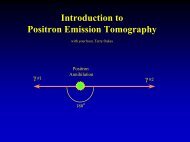
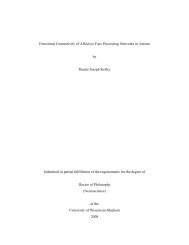
![[F-18]-L-DOPA PET scan shows loss of dopaminergic neurons](https://img.yumpu.com/41721684/1/190x146/f-18-l-dopa-pet-scan-shows-loss-of-dopaminergic-neurons.jpg?quality=85)
